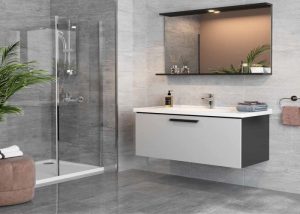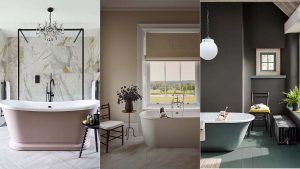Choosing the Right Hue: Should Bathroom Floors be Light or Dark?
When it comes to designing a bathroom, one of the crucial decisions homeowners face is selecting the color scheme. Among these choices, the question of whether bathroom floors should be light or dark often sparks debates. In this article, we delve into the considerations and advantages of both options to help you make an informed decision for your bathroom.
Light Floors: Illuminating the Space
Advantages of Light Bathroom Floors
Light-colored bathroom floors have their own set of advantages that make them a popular choice for many homeowners. One of the key benefits is the illusion of a larger space. Light hues, such as whites, creams, and light grays, tend to reflect more natural light, creating an open and airy feel in the room.

Additionally, light floors can seamlessly blend with various design styles. Whether you prefer a minimalist, contemporary, or traditional look, light-colored tiles or flooring can complement a wide range of bathroom aesthetics. The neutrality of light tones provides a versatile backdrop for other design elements, allowing you to experiment with different colors for walls, fixtures, and accessories.
Enhancing Cleanliness and Maintenance
Another advantage of light bathroom floors is that they often hide dust, hair, and dirt better than dark floors. Light colors make it easier to spot any debris, allowing for prompt cleaning and maintenance. This is especially beneficial in bathrooms where hygiene is a top priority.
Drawbacks of Light Bathroom Floors
Despite their numerous advantages, light bathroom floors also have some drawbacks. Stains and discoloration can be more noticeable on light-colored surfaces, requiring homeowners to be vigilant in maintaining cleanliness. Additionally, if the bathroom receives heavy foot traffic, light floors may show signs of wear and tear more quickly than their darker counterparts.
Dark Floors: Adding Drama and Sophistication
Advantages of Dark Bathroom Floors
Dark-colored bathroom floors bring a sense of drama and sophistication to the space. Rich tones such as deep grays, browns, and blacks can create a cozy and intimate atmosphere, making the bathroom a retreat for relaxation. Dark floors also have the advantage of concealing stains and dirt, making them a practical choice for high-traffic bathrooms or households with children and pets.
Additionally, dark floors can serve as a bold design statement, allowing you to highlight other elements in the room. Whether paired with light-colored walls, vibrant fixtures, or unique accessories, dark floors can provide a striking contrast that enhances the overall aesthetic appeal of the bathroom.
Considerations for Small Spaces
While dark floors can add sophistication, they may not be the best choice for smaller bathrooms. Dark colors tend to absorb light, potentially making the space feel cramped and confined. In such cases, it’s crucial to balance the color scheme by incorporating ample lighting and lighter tones in other aspects of the bathroom design.
Drawbacks of Dark Bathroom Floors

One of the main drawbacks of dark bathroom floors is their tendency to show dust and debris more than light floors. Regular cleaning and maintenance are essential to keep dark floors looking their best. Additionally, scratches and imperfections may be more visible on dark surfaces, requiring careful handling and protection to maintain the floor’s integrity over time. For sydney home and renovations kitchen bathroom renovations we can help.
Making the Decision: Factors to Consider
1. Natural Light: Assess the amount of natural light your bathroom receives. If it’s limited, light floors may be a better choice to enhance brightness and create a more inviting atmosphere.
2. Bathroom Size: Consider the size of your bathroom. In smaller spaces, light floors can create an illusion of expansiveness, while larger bathrooms may afford the luxury of experimenting with darker tones.
3. Design Preferences: Your personal style and design preferences play a significant role. If you lean towards a modern, sleek look, light floors may be more suitable. If you prefer a cozy, luxurious ambiance, dark floors could be the perfect fit.
4. Maintenance Commitment: Be honest about your willingness to commit to regular cleaning and maintenance. Light floors may require more attention to keep them looking pristine, while dark floors may be forgiving in terms of visible stains but demand careful care to prevent scratches and wear.
Conclusion: Finding the Perfect Balance
Ultimately, the choice between light and dark bathroom floors depends on a combination of practical considerations and personal preferences. By weighing the advantages and drawbacks of each option, you can find the perfect balance that aligns with your aesthetic vision and lifestyle.
Whether you opt for the illuminating effect of light floors or the dramatic allure of dark ones, your bathroom floor choice will undoubtedly contribute to the overall character and atmosphere of the space. Take the time to explore various options, envision the desired look, and create a bathroom that not only meets your functional needs but also reflects your unique style.


Thanks in support of sharing such a pleasant thought, article is nice, thats why i hawve read it entirely http://boyarka-inform.com
Hi to every one, becausze I amm truly eager off reading this webpage’s post
to be updated regularly. It includes pleasant stuff. http://Boyarka-Inform.com/